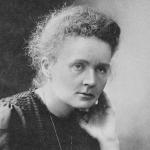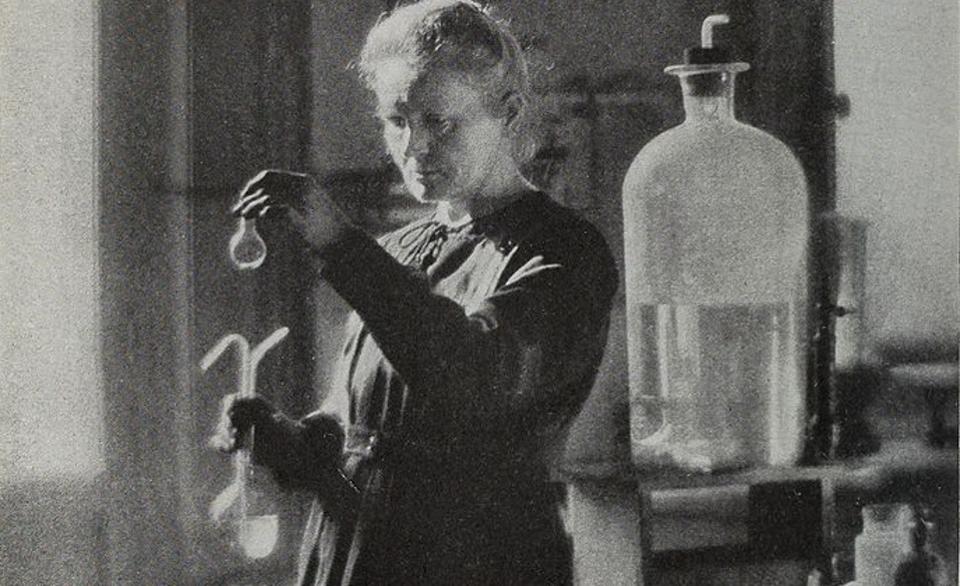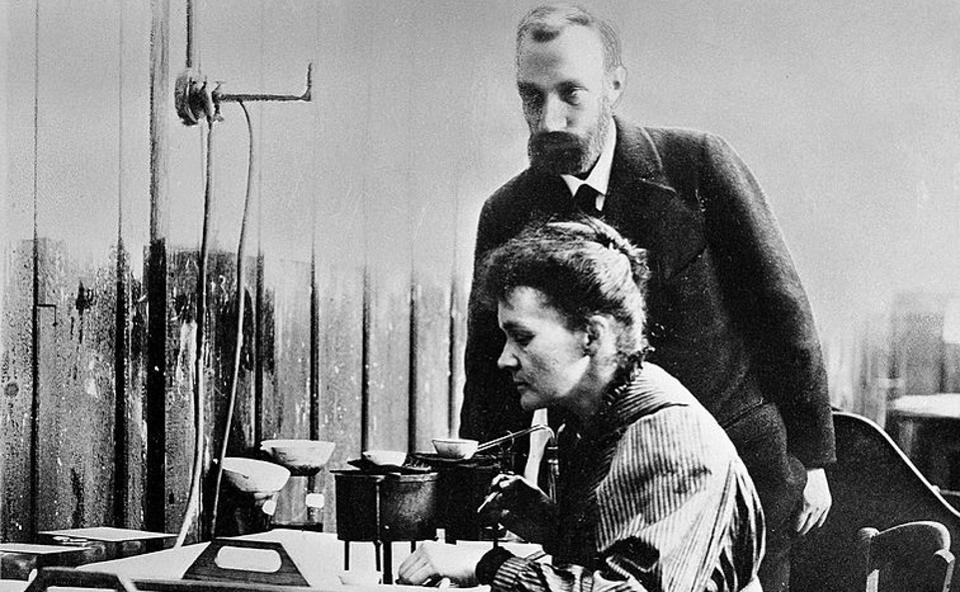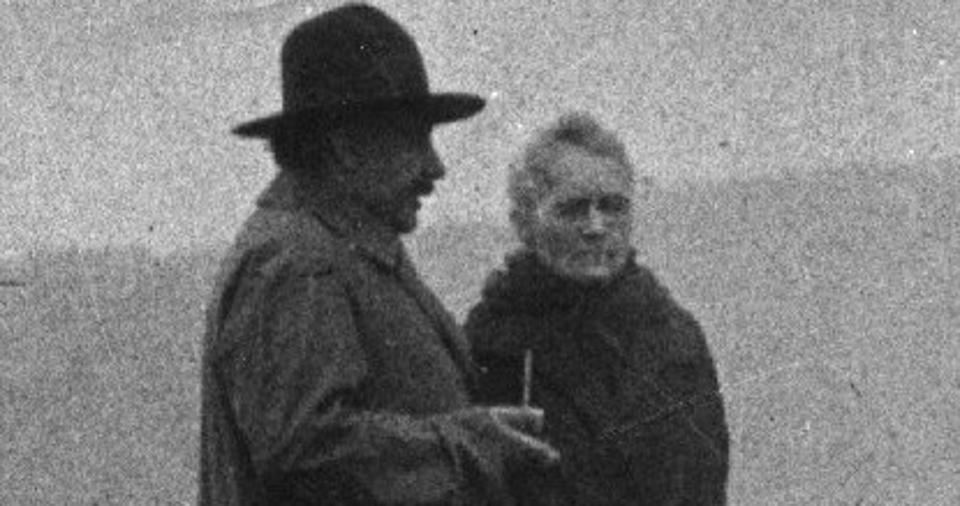It's Marie Curie's 150th Birthday, And Her Legacy Deserves More Nuance

Today marks the 150th birthday of the most famous woman in science, Marie Curie, but making sense of her story remains a challenge. In the decades since Curie’s death, her story has been framed, at different times, as a romantic tragedy of lone geniuses sacrificing themselves for discovery, a cautionary tale about lab safety, and a punchline.
Perhaps the best way to begin an approach to Curie’s legacy is through the material she left behind. Her notebooks remain too hot to handle even after a century, and will likely remain so for another 1600 years. The Biolotheque Nationale in France keeps them in lead boxes, and even her furniture and other personal belongings are radioactive enough that visitors have to wear protective clothing and sign a liability waiver. That’s the deadly, persistent stuff Curie spent her career working with.

Curie in her lab in 1925 American Museum of Natural History
She died in 1934 at the age of 66. Decades of radiation exposure in the lab had given her a condition called aplastic pernicious anemia. Her daughter Irene died in 1956 of leukemia, which doctors say was probably the result of radiation exposure in her own work.
But from 1901 until her death, Curie discovered two chemical elements, polonium and radium, and she coined the term “radioactivity.” She won two Nobel Prizes – one shared with her husband and a colleague, and a second on her own. During the First World War, the widowed Curie toured battlefields in a mobile X-ray truck, with her then teenage daughter Irene, to help treat wounded soldiers with the phenomenon she helped discover.
The Curie story is compelling. It's a family legacy: she worked alongside her husband Pierre Curie until his death in a 1906 traffic accident, and then with her daughter Irene, who went on to win a Nobel Prize in Chemistry for her own work on radioactive elements. And then there’s the haunting fact that she died because of her work with the elements she discovered and named. The challenge is how to position that narrative when we think about promoting gender equality in the sciences, understanding how science is done, and deciding which risks are acceptable for modern scientists to take.

Marie and Pierre Curie in the lab Wellcome Images
A Role Model for Women in STEM
Marie Curie is undeniably a pioneer who helped pave the way for women in science. The youngest daughter of two Polish schoolteachers, she earned her way into the Sorbonne and then two Nobel Prizes. However, we can’t talk about Curie’s awards and what they mean for women in science without also talking about the fact that she is one of only two women to ever win the award for physics, and one of just 49 to hold a Nobel Prize at all. Her deservedly towering figure often overshadows other women who have made equally substantial contributions to science, along with the lack of recognition they’ve received for their work.
One of them, Marguerite Perey, a technician in Curie's lab, discovered Francium in 1934. That earned her a grant to pursue her doctorate at the Sorbonne, which she completed in 1946. Three years later, she became head of the department of nuclear chemistry at the University of Strasbourg, where she studied francium as a potential tool for diagnosing and treating cancer.
"But before long, she grew sick," wrote her great-great-niece Veronique Greenwood in a 2014 New York Times piece:
"We know now that alpha and beta particles emitted in radiation attack DNA and that the mutations they cause can lead to cancer. Ingested radioactive elements can concentrate in the bones, where they continue their decay, in effect poisoning someone for as long as that person lives. By the time Perey made her discovery, she was already heavily contaminated. She spent the last 15 years of her life in treatment for a gruesome bone cancer that spread throughout her body, claiming her eyesight, pieces of her hand and most of the years in which she had planned to study francium. As the disease progressed, she warned her students of the horrible consequences of radiation exposure. Francis, my grandfather, says he recalls hearing that when she walked into labs with radiation counters in her later years, they would go off."
Challenging the Lone Genius
Perey’s story underscores another challenge in approaching Curie’s legacy. History loves a story about a lone hero who saves the day. In the popular imagination and in most secondary-school textbooks, the story of the Battle of Waterloo has become mostly the story of the Duke of Wellington, not the thousands of men under his command. The story of Trafalgar is the story of Admiral Nelson. And science history loves its lone geniuses.
The lone genius narrative doesn’t capture how real science gets done. Discoveries come out of the efforts of many intelligent, driven people working together. For example, although only three people won this year’s Nobel for the detection of gravitational waves, thousands contributed in important ways to the discovery. Curie, later in her career, worked with a staff of scientists, technicians, and research assistants at her Radium Lab in Paris – including Perey. Curie was indisputably a genius and a compelling figure whose personality drove her lab’s work, but she never truly worked alone. She could not have; no scientist could.

Marie Curie and Albert Einstein Unknown, via Wikimedia Commons
Risking It All For Science?
And knowing that casts a different light on the risks she took. Far from a lone genius who took her own life in her hands, Curie was also responsible for the safety of her employees and colleagues.
In the early days of Curie’s work, it still appears possible to frame her legacy as a testament to the dangers of exploring the unknown. She was part of the team that discovered radiation in 1901, and it wasn’t long before she, her husband, and their colleague Henri Becquerel all reported burns on their hands after handling radium. Perhaps a more prudent group of scientists would have begun to take precautions, if they hadn’t already, but in fairness to the Curies, prudence wasn’t much of a part of scientific culture in the early 20th century.
But by the 1910s, people who worked with X-rays had begun to display symptoms ranging from hair loss to fatal cancer. In 1928, just a few months before Perey joined the Radium Lab, a group of young female workers at the United States Radium Corporation won a landmark court case after years of exposure to radium, which they used to paint glowing numbers onto watch faces. They suffered cancer, anemia, and other ailments.
At the Radium Lab, many accounts indicate that Curie and her daughter drove a culture of carelessness in her lab long after the dangers of radiation became too well-known to ignore. Eyewitness accounts, photographs, and other documentation from the Radium Lab paint a horrifying picture of lab assistants moving radioactive material around with little or no shielding, pouring radium between containers without even a pair of gloves for protection, and even mouth-pipetting polonium (that one was Irene Curie herself). Several chemists died there.
On her 150th birthday, that leaves us with the question of how to view Curie and her work. It would be wrong to downplay the significance of her scientific discoveries or her equally groundbreaking career, but it’s important not to focus on the temptingly romantic version of her story at the expense of a more clearheaded look at her legacy and what it means to modern science. The story, as it always is in science, is more complex than that.
"We should celebrate scientists not solely for their accomplishments but also for their courage and the tenacity required to discover anything at all. There are brave people out there working right now. They are brave not because they are killing themselves slowly or leaping from airplanes or catching rare tropical diseases, although scientists have done all those things. They are brave because of the intense emotional risks of trying to do something no one has done before by following your own lead," wrote Greenwood.
_________________________________________________
K.N Smith writes: "I am a freelance science journalist, bringing you interesting science tidbits, tales of discovery and critical looks at everything from deadly diseases to space exploration. I’ve written, online and in print, for Air & Space, Astronomy, Discover, Drone360, Gizmodo, Popular Mechanics and the Washington Post. I hold a B.A. in Anthropology from Texas A&M University, and I’m currently based in Tulsa, where I share my office with a border collie and a crested gecko."
